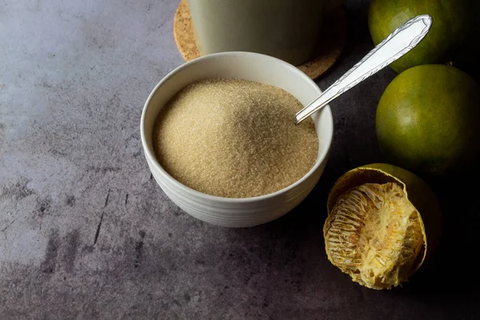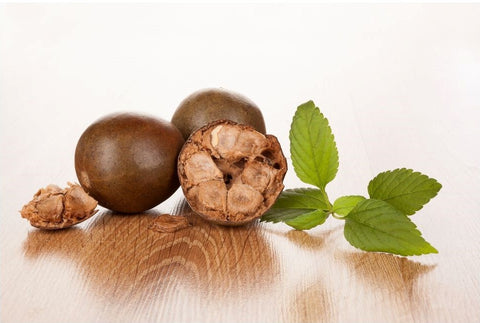Curious About Monk Fruit?
What is Monk Fruit?

(Image Courtesy of the Food Network)
Monk fruit (Siraitia grosvenorii) also known as Luo Han Guo is a perennial vine that produces a round green fruit native to the southern regions of China. Another fun name that you might encounter is Swingle fruit. It is a distant cousin of the melon and cucumber. Historically, monk fruit was used in Chinese medicine as a cough suppressant and to support the immune system, despite being extremely rare.
Today, it is widely recognized as a low-calorie, sugar-free sweetener that comes from a natural source, unlike other artificial sweeteners and sugar alcohols that are artificially produced. The chemical compounds responsible for monk fruit's sweetness are known as mogrosides while most other fruits attribute their sweetness to fructose. A little goes a long way with monk fruit extract, which is 200-300 times sweeter than regular table sugar (sucrose). One key reason for using monk fruit in Amari's product line is the decreased bitter aftertaste commonly linked to artificial sweeteners and sugar alcohols. Monk Fruit has been granted GRAS (Generally Recognized as Safe) status by the FDA.
Say Goodbye to Sugar!
Complementing our functional ingredients, Amari incorporates monk fruit to add a touch of sweetness to its range of sports recovery drinks. All in a formula that is free of bubbles, caffeine, and sugar.
Monk Fruit Benefits
-
Provides a sweet taste without the added calories and carbohydrates found in sugar.
-
Helpful for managing blood sugar levels and reducing insulin spikes.
-
No GI upset associated with other sugar alcohols or alternative sweeteners.
-
Has not been shown to impact the gut microbiome like some of the other sweetener alternatives, such as Sucralose and Saccharin, according to a small study.
-
The chemical compounds in monk fruit, known as mogrosides, have shown antioxidant properties to protect healthy cells at higher consumption levels.
What is the process for making monk fruit?

(Image courtesy of depositphotos)
The fruit goes through a water extraction process where it is macerated, separating the juice from the pulp. From here, the juice is filtered and sweetening components are selectively concentrated. The concentration process results in a liquid extract that can be further clarified or transformed into a powder form that dissolves easily. The ripe fruit contains approximately 0.55 – 0.65% of the sweet mogrosides compounds. The dried monk fruit contains approximately 2.5% of the sweet mogrosides due to the natural reduction of water as the fruit dries and intensifies the sweetness level.
History of Monk Fruit
The famous Chinese text monograph, Bencao Gangmu, written during the Ming Dynasty, was the first book to document the medical uses of monk fruit. Dating back 2,000 years ago and commonly brewed as a tea, it was utilized as an expectorant to alleviate sore throats, hydrate and nourish the lungs, and dispel heat from the body. This fruit, despite its health benefits, was not commonly employed as medicine because of its scarcity.
Where did the name “monk fruit” originate from? Legends suggest that monks were the original cultivators of the fruit. Buddhist monk masters in China are called the “Luo Han”, the monk fruit itself embodies this nature – cool, unique, and peaceful.

Learn More About Monk Fruit
A number of studies and reviews have been gathered to showcase the effectiveness and advantages of monk fruit. To access the scientific research, please click on the links provided.
Review of Monk Fruits Health Benefits and Applications – This review takes a big picture look at the benefits of monk fruit ranging from its versatility in food products to the associated health benefits.
Detailed Information on the Processing and Safety of Monk Fruit – This article from the EU takes a deep dive into the use of monk fruit in food processing and touches on safety.
A Comprehensive Review of the Current Literature about Monk Fruit – This is a great bibliometric analysis of the current literature on monk fruit available. Several trials have been conducted on animals and the next step will be more detailed human trials.
Artificial Sweeteners have potential to Negatively Impact Gut Health – A small study conducted on heathy adults indicated that Sucralose (Splenda) and Saccharin consumption could negatively impact gut microbiome health. More studies need to be conducted on different population groups before these findings are considered conclusive.
A 2018 Study Investigating the Antioxidant Activities of Mogroside Extract – This study aims to explore the antioxidant capabilities of mogroside extract derived from monk fruit. More research continues to be conducted on this topic.
A Review of Chinese Food-Medicine Related to Monk Fruit – This article reviews the literature from the past 36 years to compile information on how monk fruit was traditionally used and takes a deeper look at the compounds within the fruit.



